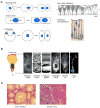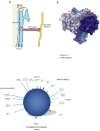Nuclear positioning
- PMID: 23498944
- PMCID: PMC3626264
- DOI: 10.1016/j.cell.2013.02.031
Nuclear positioning
Abstract
The nucleus is the largest organelle and is commonly depicted in the center of the cell. Yet during cell division, migration, and differentiation, it frequently moves to an asymmetric position aligned with cell function. We consider the toolbox of proteins that move and anchor the nucleus within the cell and how forces generated by the cytoskeleton are coupled to the nucleus to move it. The significance of proper nuclear positioning is underscored by numerous diseases resulting from genetic alterations in the toolbox proteins. Finally, we discuss how nuclear position may influence cellular organization and signaling pathways.
Copyright © 2013 Elsevier Inc. All rights reserved.
Figures



References
-
- Attali R, Warwar N, Israel A, Gurt I, McNally E, Puckelwartz M, Glick B, Nevo Y, Ben-Neriah Z, Melki J. Mutation of SYNE-1, encoding an essential component of the nuclear lamina, is responsible for autosomal recessive arthrogryposis. Hum Mol Genet. 2009;18:3462–3469. - PubMed
-
- Bione S, Maestrini E, Rivella S, Mancini M, Regis S, Romeo G, Toniolo D. Identification of a novel X-linked gene responsible for Emery-Dreifuss muscular dystrophy. Nat Genet. 1994;8:323–327. - PubMed
Publication types
MeSH terms
Grants and funding
LinkOut - more resources
Full Text Sources
Other Literature Sources

